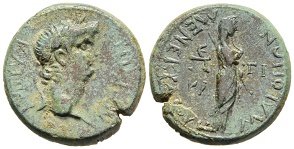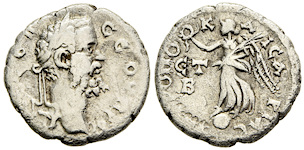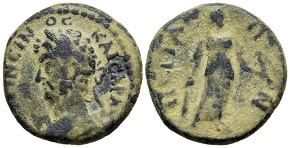Fine Coins Showcase
Antiquities Showcase
Show Empty Categories
Shop Search
Shopping Cart
My FORVM
Contact Us
About Forum
Shopping at Forum
Our Guarantee
Payment Options
Shipping Options & Fees
Privacy & Security
Forum Staff
Selling Your Coins
Identifying Your Coin
FAQs
zoom.asp
Home ▸ Catalog ▸ |Greek Coins| ▸ |Greek Imperial| ▸ |Asia Minor & Cyprus||View Options:   | | | | | | |


RP110696. Bronze AE 23, Krzyzanowska XVIII/35; SNG BnF 1182 (Elagabalus); BMC Lycia -, aVF, near centered, brown tone, weight 5.227 g, maximum diameter 23.3 mm, die axis 0o, Antioch in Pisidia (Yalvac, Turkey) mint, c. 205 A.D.; obverse IMP CAES M AVR ANTONINVS A, laureate head right, bare right shoulder seen from behind; reverse ANTIOCH GEN COL CAE, Genius of the colony standing left, branch downward in right hand, cornucopia in left hand; scarce; SOLD
Augustus, 16 January 27 B.C. - 19 August 14 A.D., Lampsakos, Mysia


Priapus or Priapos was a minor rustic fertility god, protector of livestock, fruit plants, gardens and male genitalia. Priapus is marked by his absurdly oversized permanent erection, which gave rise to the medical term priapism. He became a popular figure in Roman erotic art and Latin literature, and is the subject of the often humorously obscene collection of verse called the Priapeia. Statues of Priapus were sometimes placed on boundaries and hung with signs which threatened sexual assault on trespassers.RP111641. Bronze AE 16, RPC I 2275 (5 spec.); BMC Mysia p. 87, 78; SNG BnF 1267 var. (rev. leg. arrangement); SNG Cop -, F, green patina, rough, earthen deposits, weight 2.586 g, maximum diameter 15.8 mm, die axis 0o, Lampsakos (Lapseki, Turkey) mint, 16 Jan 27 B.C. - 19 Aug 14 A.D.; obverse CEBACTOY, youthful laureate head of Augustus right, star lower right; reverse LAM-ΨAK (counterclockwise from upper right), ithyphallic Priapus standing left, right hand raised, left hand on hip; scarce; SOLD
Lucius Verus, 7 March 161 - February 169 A.D., Perga, Pamphylia


RP111826. Bronze AE 20, Apparently unpublished; RPC Online IV.3 -, BMC Lycia -, SNG BnF -, SNGvA -, SNG Cop -, Lindgren -, F, centered on a tight flan, high points unstruck, porous brassy bare metal, small edge splits/cracks, weight 5.290 g, maximum diameter 19.8 mm, die axis 180o, Perga (near Antalya, Turkey) mint, 7 Mar 161 - Feb 169 A.D.; obverse AVT KAI Λ AVP OYHPOC (or similar), laureate, draped, and cuirassed bust right, seen from behind; reverse ΠEPΓ-AIΩN, Artemis standing slightly right, head right, raised torch in left hand, bow in right hand, stag or hind right at her feet to right; this is the only specimen of the type known to FORVM; extremely rare; SOLD
Valerian I, October 253 - c. June 260 A.D., Nicaea, Bithynia


Nicaea remained an important town throughout the imperial period. Although only 70 km (43 miles) from Constantinople, Nicaea did not lose its importance when Constantinople became the capital of the Eastern Empire. The city suffered from earthquakes in 358, 362 and 368; after the last of which, it was restored by Valens. During the Middle Ages, it was a long time bulwark of the Byzantine emperors against the Turks.RP111942. Bronze AE 26, SNGvA 713 var. (obv. leg., bust, etc.); Rec Gen II.3 p. 501, 804 - 806 var. (same); BMC Pontus -; SNG Cop -; SNG Tübingen -, gF, broad flan, dark green patina, highlighting earthen deposits, light scratches, central dimples, weight 9.078 g, maximum diameter 27.2 mm, die axis 0o, Nicaea (Iznik, Turkey) mint, Oct 253 - c. Jun 260 A.D.; obverse ΠOY ΛIK OVAΛEPIANOC CE, radiate bust left wearing imperial mantel; reverse NIK-A-I-EΩN, Valerian and Gallienus standing confronted, both radiate and wearing military garb, clasping hands, each holding long scepter or spear; priest on right, veiled and togate, standing left, sacrificing from phiale over small altar at feet; rare; SOLD
Nero, 13 October 54 - 9 June 68 A.D., Maionia, Lydia


The figure on the reverse is variously interpreted as Boule (Imhoof-Blumer, LS, p. 93), Hestia (BMC Lydia) or Demeter (Waddington).RP112029. Leaded bronze AE 18, GRPC Lydia III p. 52, 78; RPC Online I 3011; SNG Cop 231; SNGvA 3016; SNG Tub 3722; SNG Mun 311; BMC Lydia p. 131, 32; Waddington 5062; McClean 8672, VF, mottled blue green patina, well centered, edge splits, weight 4.321 g, maximum diameter 18.4 mm, die axis 0o, Maionia (near Koula, Turkey) mint, strategos Tiberius Claudius Menecrates, c. 65 A.D.; obverse NEPΩN KAIΣAP (counterclockwise from lower right), laureate head right; reverse MAIONΩN MENEKPATOYΣ (of Maionia, Menecrates, counterclockwise from lower right), veiled goddess (Hestia?) standing right, pulling out drapery from breast with right hand, transverse scepter in left hand, EΠ - TI / KΛ (authority of Tiberius Klaudius) across fields; SOLD
Apameia ad Maeandrum, Phrygia, c. 193 - 235 A.D.


Hecate or Hekate is an underworld goddess of archaic origin associated with magic, childbirth, nurturing the young, gates and walls, doorways, crossroads, lunar lore, torches and dogs. During the Hellenistic period, she appeared as a three-faced goddess associated with ghosts, witchcraft, and curses. Today she is popular with modern witches and neo-pagans.GB112272. Bronze AE 15, SNG Cop 195; SNG Munchen 131; SNGvA 3475; BMC Phrygia p. 88, 110; Lindgren I 898; SNG Tüb -, VF, attractive style, green patina, highlighting earthen deposits, weight 2.694 g, maximum diameter 16.2 mm, die axis 180o, Phrygia, Apameia ad Maeandrum (Dinar, Turkey) mint, c. 193 - 235 A.D.; obverse AΠAMEIA, turreted and draped bust of Tyche right; reverse CΩTEIPA, Hekate triformis (triple-bodied) standing facing, polos on each head, torch in each hand; scarce; SOLD
Septimius Severus, 9 April 193 - 4 February 211 A.D., Caesarea, Cappadocia


Kayseri, originally called Mazaka or Mazaca, is in central Turkey on a low spur on the north side of Mount Erciyes (Mount Argaeus in ancient times). During Achaemenid Persian rule, it was the capital of a Satrapy on the crossroads of the Royal Road from Sardis to Susa and the trade route from Sinope to the Euphrates. It was conquered by Alexander's general Perdikkas, was ruled by Eumenes of Cardia, then passed to the Seleucid empire after the battle of Ipsus. It became the capital of the independent Cappadocian Kingdom under Ariarathes III, around 250 B.C. During Strabo's time it was also known as Eusebia, after the Cappadocian King Ariarathes V Eusebes, 163 – 130 B.C. The name was changed again to "Caesarea in Cappadocia" in honor of Caesar Augustus, upon his death in 14 A.D. The city passed under formal Roman rule in 17 A.D. In Roman times, it prospered on the route from Ephesus to the East. Caesarea was destroyed by the Sassanid King Shapur I after his victory over the Emperor Valerian I in 260 A.D. At the time it was recorded to have around 400,000 inhabitants. Arabic influence changed Caesarea to the modern name Kayseri. The city gradually recovered and has a population of almost 1 million people today. Few traces of the ancient city survive.RP112937. Silver drachm, Ganschow 338f; Hensler 682; cf. Sydenham Caesarea 392; BMC Cappadocia p. 75, 234; SNG Cop VII -; SNG Leypold II -, F, tight flan, toned, scratches, tiny edge cracks, weight 2.581 g, maximum diameter 17.5 mm, die axis 0o, Cappadocia, Caesarea (Kayseri, Turkey) mint, 194 A.D.; obverse AY KAI Λ CEΠ CEOYHPOC, laureate head right; reverse MHTPOΠO KAICAPIAC, Victory standing left on globe, raising wreath in right hand, palm frond in left hand, ET above B (year 2) in left field; 1very scarce; SOLD
Marcus Aurelius, 7 March 161 - 17 March 180 A.D., Perga, Pamphylia


Perga was the capital of Pamphylia. Today it is a large site of ancient ruins, 15 kilometers (9.3 mi) east of Antalya on the southwestern Mediterranean coast of Turkey. During the Hellenistic period, Perga was one of the richest and most beautiful cities in the ancient world, famous for its temple of Artemis. It also is notable as the home of the renowned mathematician Apollonius of Perga.RP113232. Bronze AE 19, RPC Online IV.3 T10660 (4 spec.), SNG BnF 435, SNG Cop -, SNGvA -, BMC Pamphylia -, aVF, dark patina, earthen encrustation, scratches, weight 5.225 g, maximum diameter 19.4 mm, die axis 180o, Perga (near Antalya, Turkey) mint, 161 - 180 A.D; obverse ANTONIΩN-OC KAICAP AV, laureate bust left with slight drapery on far shoulder; reverse ΠEPΓ-AIΩN, Artemis standing slightly right, head right, wearing quiver over shoulder, holding arrow and bow; ex CNG e-auction 534 (15 Mar 2023), lot 360; very rare; SOLD
Agrippina Junior, Augusta 50 - March 59 A.D., Aezanis, Phrygia


The frequent association of Agrippina Junior with Persephone may relate to the unusual marriage of Agrippina to her Uncle Claudius, as Persephone had married her uncle Hades. Some coins of her mother Agrippina Senior show Demeter, who was the mother of Persephone.RP113266. Bronze AE 17, RPC Online I 3103 (8 spec.); BMC Phrygia p. 35, 93; SNG Cop -; SNGvA -, F, earthen encrustation, weight 3.267 g, maximum diameter 17.3 mm, die axis 0o, Aezanis (Cavdarhisar, Turkey) mint, 50 - March 59 A.D.; obverse AΓPIΠΠINA ΣEBAΣTHN (clockwise from upper right), diademed bust of Agrippina II right; reverse AIZA-NITΩN (clockwise from upper right), veiled bust of Persephone right, poppy and two grain ears before her; rare; SOLD
Octavia, Augusta, 54 - 62 A.D., Sardes Lydia


Sardis was the capital of the Kingdom of Lydia, an important city of the Persian Empire, a Roman proconsul seat, and in later Roman and Byzantine times the metropolis of the province Lydia. In the Book of Revelation, Sardis, one of the Seven Churches of Asia, is admonished to be watchful and to strengthen since their works haven't been perfect before God. (Revelation 3:1-6).RP114404. Bronze AE 19, GRPC Lydia IV 384, RPC Online I 2998 (5 spec.), SNG Cop -, BMC Lydia -, aF, parts of legends weak, porous, weight 5.454 g, maximum diameter 18.5 mm, die axis 0o, Sardes (Sart, Turkey) mint, Mindios (strategos for the 2nd time), c. 60 A.D.; obverse ΘEAN OKTAOYIAN (counterclockwise from upper left), draped bust right, wreathed with grain; reverse EΠI MINΔIOY (counterclockwise from upper right, under Mindios), Demeter standing half left, holding grain and transverse scepter, CAPΔIANΩN (upward on right), CTPA TO B (ligatures, strategos for the 2nd time) in left field; scarce; SOLD

You are viewing a SOLD items page.
Click here to return to the page with AVAILABLE items.
The sale price for a sold item is the private information of the buyer and will not be provided.



Page created in 1.625 seconds.








